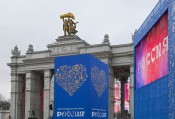
The Presidential Library illustrates the History of Crimea at RUSSIA EXPO
On March 17, 2024, on the eve of the 10th anniversary of the reunification of Crimea with Russia, the chief bibliographer of the bibliography and cataloging department of the Presidential Library, Anna Vorobyova, spoke to visitors to RUSSI EXPO at VDNKh in Moscow. As part of the educational program of the Russian Society “Znanie”, she spoke about materials from the Presidential Library's collection dedicated to the history of the Crimean Peninsula.
The Presidential Library's portal features electronic collections: “Crimea in Postcards”, “Crimean War 1853–1856” and the main collection “Republic of Crimea: Pages of History”, which includes studies, essays, archival documents, photographs and other materials introducing the administrative , socio-economic, socio-political and cultural development of the peninsula from ancient times to the present day.
Crimea, due to its geographical location, has always been a strategically important territory. Different peoples fought for power over the peninsula: from nomads and Greeks, to Genoese and Turks.
Crimea also played a special role in the history of Russia. In April 1783, the manifesto “On the acceptance of the Crimean peninsula, Taman Island and the entire Kuban side under the Russian state” was signed. Four years after this event, Catherine the Great traveled through Crimea.
The peninsula quickly became an important part of the Russian Empire. Sevastopol, founded in 1784, became the main military base on the Black Sea.
By the middle of the 19th century, Sevastopol was finally strengthened as the main base of the Black Sea Fleet. But peaceful life was interrupted by the Crimean War, which lasted from 1853 to 1856. Türkiye, England, France and the Sardinian Kingdom simultaneously opposed Russia.
Sevastopol, which was under siege for a year, was defended by Pavel Nakhimov and Vladimir Kornilov. Both admirals were killed. Despite the fact that the Russian Empire was defeated in that war, Crimea still remained its territory.
The peninsula quickly recovered after the war and was connected to mainland Russia by railroad. Livadia turned into the southern residence of the imperial family. During this period, hotels, theaters, and hospitals were actively built here. The peninsula has become a popular holiday destination, including for prominent figures of Russian culture - N. Gogol, A. Chekhov, L. Tolstoy, M. Gorky came here.
The peninsula was not spared by the dramatic events of the early 20th century – the First World War and the Civil War. First, the Bolsheviks established power in Crimea, occupying Feodosia, Simferopol, Yalta and Kerch. However, already in the spring of 1918, German troops landed on the peninsula, and power was in the hands of the Crimean regional government. In November he was replaced by the Second Crimean Regional Government, which was supported by the Entente countries.
Further the events developed rapidly. For several months the government of the Crimean Soviet Socialist Republic ruled the peninsula. Then power passed to Anton Denikin, and then to Peter Wrangel. Ultimately, the Red Army managed to defeat the White Guards, and it was from Crimea that they went into exile. The peninsula plunged into the abyss of red terror.
One tragedy was replaced by another - on June 22, 1941, the Great Patriotic War began. Until July 1942, Soviet troops held the defense of Crimea and Sevastopol. But the forces were unequal, and there was no support from the mainland. After the next assault, the command decided to retreat. Only the soldiers in the Sevastopol fortified area and the Adzhimushkai quarries continued to hold the defense. However, their fate was sealed. After capturing the peninsula, the Germans faced attacks from partisan detachments. The occupation authorities responded with numerous arrests and executions.
The test of strength continued until the spring of 1944, when the Red Army managed to liberate Crimea. Sevastopol and Kerch were awarded the titles of hero cities.
More interesting facts about Crimea are available in the Presidential Library’s collections, which today exceed a million depository items. Full access to the library's resources is provided in the electronic reading room on Senate Square in St. Petersburg, in the Reserve Center in Moscow, the Branch of the Presidential Library in Tyumen Region, as well as in remote access centers in Russia and abroad.





